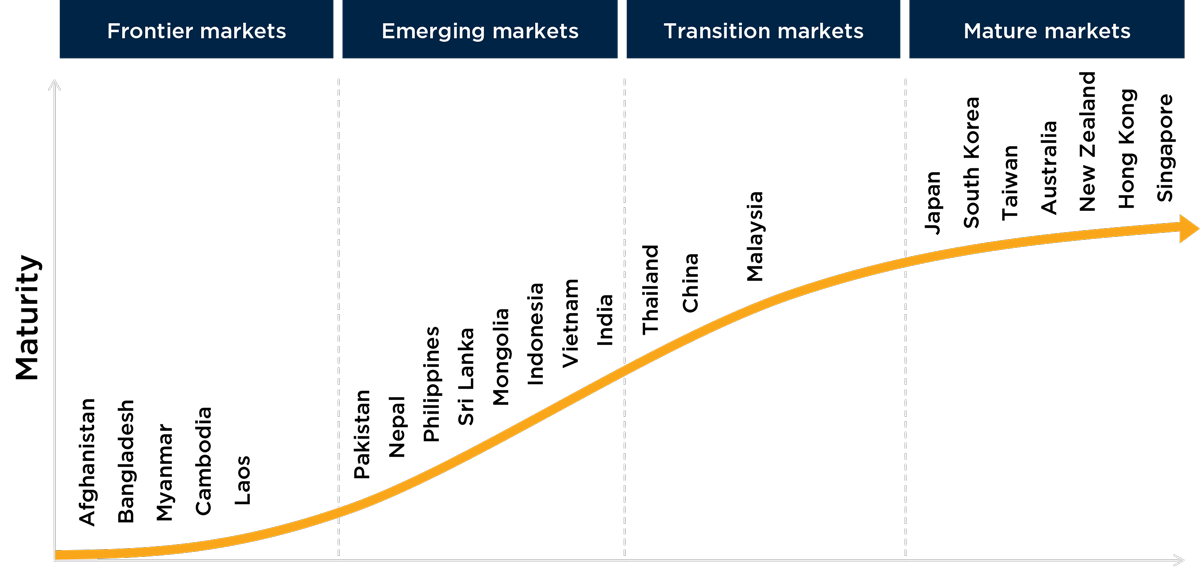We identified four distinct economic groups in the region, and we have collated countries based on market maturity. Each country was measured on economic development, ease of doing business, and digital readiness. Each of these ‘four Asia’s’ has characteristics that complement the other three and, as they integrate, the region will become more resilient and be better able to deal with global volatility. Each market group, frontier, emerging, transition, and mature needs to be considered when developing an APAC strategy as they offer different opportunities with their own set of key stakeholders and challenges to overcome.
Innovation - a key indicator
Innovation is an important measure of market maturity. The mature markets, primarily Singapore, Japan, South Korea, and Australia, have built strong innovation foundations with institutions that are providing capital and knowledge to power innovation in other Asian economies. They have invested, and continue to invest, heavily in innovation and have built up substantial intellectual property. Engaging with government stakeholders is key to being considered for large-scale infrastructure projects, but the return on investment is high.
The transition markets and the more mature countries in the emerging markets group offer huge opportunities to deploy proven business models, capital, and innovative ideas. Inefficiencies in industry offer an opportunity to leapfrog in terms of innovation, and the pace of growth of startups and funding is much faster among this group of companies than in the mature markets. Setting the pace of change and being able to shape the direction of technology development may suit some Swedish companies and establishing a loyal customer base as technologies emerge will reap rewards in the long-term.
An Asian innovation network is emerging and shows momentum and growth potential in the region. The market maturity curve graph shows the scale and speed of adoption of new solutions in each of the four market groups and the progression as countries increase the level of innovation.
The frontier markets are challenging, and for most Swedish companies, these will not be strategically, economically, or practical viable. However, it is important to remain aware of the developments in each country as rapid change is not uncommon with countries leapfrogging technology trends and shifting status.
APAC market maturity curve

Several markets offer a high level of maturity, and on a global stage show that they are at the forefront of innovation. China is leading tech entrepreneurship in APAC and with 301 unicorn companies, it ranks second globally as the biggest producer of successfully innovative companies. (Stockholm ranks second globally by city). Despite China’s influence, the region still relies on foreign input in core technologies. Mature markets such as Japan and South Korea have large tech companies and sit on a substantial knowledge base but have relatively few unicorns. The emerging markets in Southeast Asia invest relatively little in innovation but with their growing middle classes provide a substantial market for goods and services from tech leaders.
Market conditions and opportunities are not the exclusive drivers for market entry into Asia, talent is also a critical factor. India and China are often recognised as holding skilled tech talent, but this is slowly changing as growing middle class and increased public and private spending on education throughout the region is producing top tech talent in countries such as Vietnam, the Philippines, Malaysia, and Indonesia.
Over the past decade, collaboration has been a significant common denominator employed in the race to close the technology gaps that remain in APAC. Rising trade barriers threaten to disrupt global technology flows and IP and technological collaboration within and between regions remains pivotal to build on the advances that have already been made.
Government key in shaping Asia’s digital future
The rapid development of Asia’s digital ecosystems is being driven by both a vast, connected population and an emergence of Asian digital innovators. With more than half of the global internet population, development can happen rapidly, at scale. The acceleration of development has been driven by the digital innovators, who have created 40 per cent of global unicorns and fast-tracked the time to unicorn status by 50 per cent compared to Western counterparts.
But the foundation for success has been laid by governments. Investment in digital infrastructure and the creation of space for innovators to experiment is fundamental to the growth being seen today – and expected for the future. Governments across APAC are a crucial part of the equation in pushing the innovation agenda forward, recognising the economic, business, and social imperatives for digital development. Across Asia, governments have acted with a variety of approaches, including:
- Worked collaboratively with local tech companies in emerging areas like renewable energy and AI
- Built partnerships during the pandemic to accelerate digitalisation and automation for essential services including track-and-trace and digital QR-codes
- Supported experimenting and testing of mobile payment systems
- Actively promoted new technology
- Responded to pressure on government and businesses to embrace sustainability
- Upgrading manufacturing capabilities and Industry 4.0 - ‘Made in China 2025’ aims to upgrade manufacturing and transition to smart factories and companies in Southeast Asia are likely to follow
APAC FinTech a leading global disruptor
In the next decade, consumers in Asia are expected to account for over half of global consumption growth. Upward mobility and an increase in demand for consumer goods and services is also shaking up the FinTech sector with a ‘mobile-first’ approach fuelling the rise of digital ecosystems and forcing traditional banks to keep up.
While the FinTech revolution began prior to the pandemic, it has accelerated with the deployment of digital banking, digital wallets, P2P lending, payment gateways, and other solutions.
There has been an overarching acknowledgment that the integration of new technologies is key to long-term success and growth. While not mainstream yet, blockchain technology is slowly breaking through with some larger retailers starting to accept cryptocurrency as a payment method.
Bold action a key ingredient for success
APAC is a market that can’t be ignored. But Swedish companies need to be bold and take proactive action if they want to win both in the short- and long-term. While large opportunities exist for Swedish companies of all sizes, market research, a robust strategy, and understanding of local factors are imperative to make it big in the world’s economic powerhouse.
Swedish companies need to:
- Understand market context and adjust the service or solution to the market. One size does not fit all and what might work at home, or in another APAC market, may not be right for your new target
- Factor in start-up and ongoing costs, how do these impact on the return on investment in the short- and long-term
- Be ready to work to find the right talent in highly competitive markets where both local and international talent is in high demand
- Build partnerships that compliment and support business and growth ambitions
- Raise capital in the region with a clear focus on market expansion
While several APAC countries are at the forefront of digital technology and innovation and change is high on the agenda, gaps across the region remain significant. Enhancing technological collaboration within, and among regions, remains a priority across APAC and Swedish companies can make the most of the ambitions and pace of development.
- Business Sweden recommends Swedish companies seize the opportunity to experiment, pilot and innovate in the region and be part of the next wave of growth companies. However, considering innovation potential is important and Swedish companies should consider the following when choosing a local presence in Asia:
- What local innovation exists and how can they be leveraged to strengthen your business and differentiate your products and/or services?
- How do the local business ecosystems operate and where are the opportunities that are accelerating innovation?
- Are there local digital disruptors that are adapting and innovating technologies that can inform how your products/services can be implemented and tailored to local customer across APAC?
Turning APAC opportunities into growth can bring substantial rewards, but Swedish companies must be prepared to act boldly, adapt quickly, and think locally. To maximise your potential in the region, our local teams can help you identify partners and markets that are best suited to your company’s offer.






